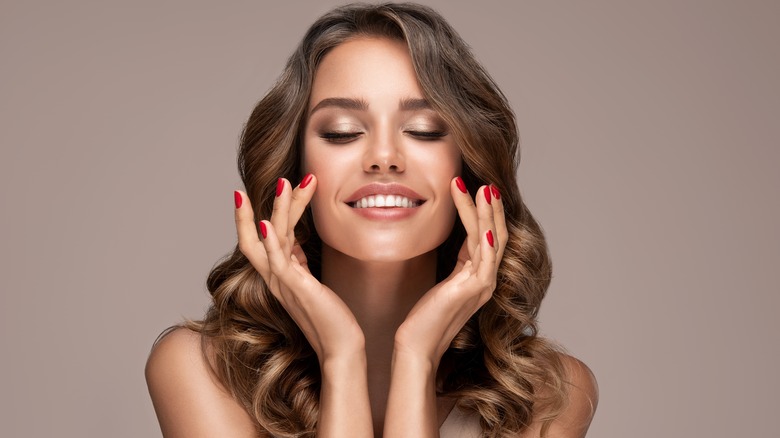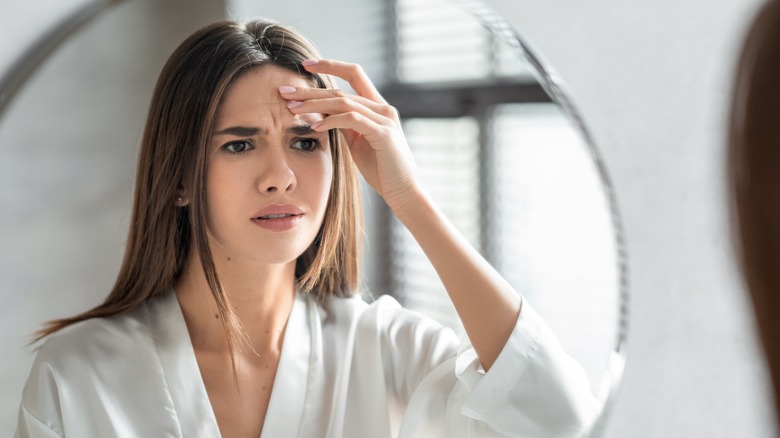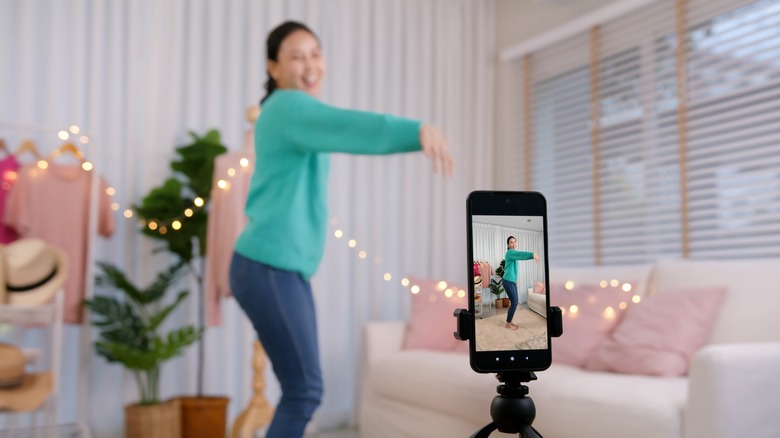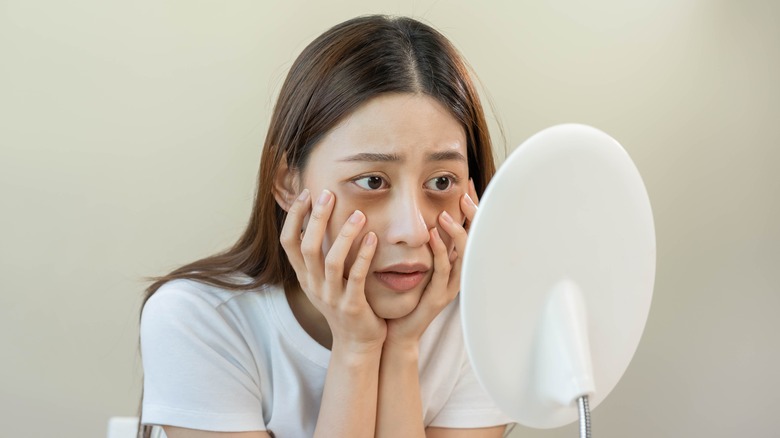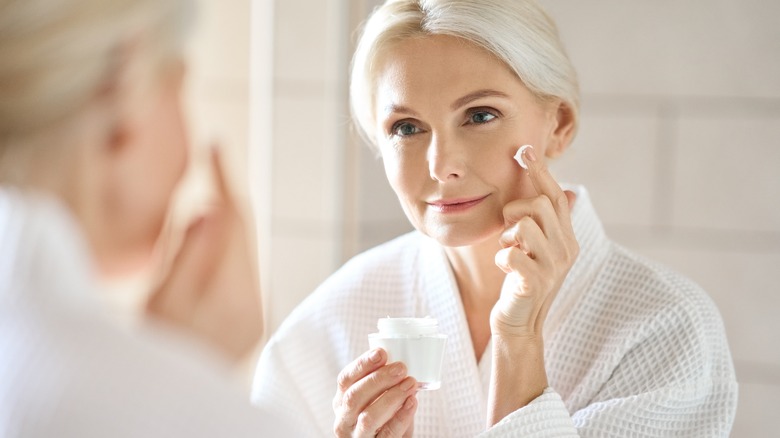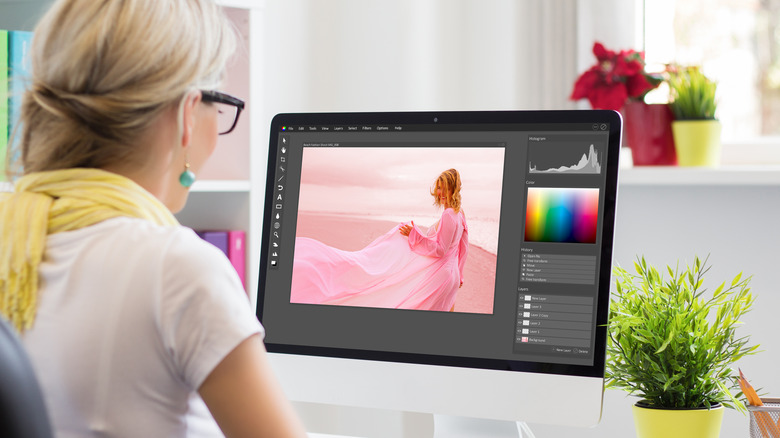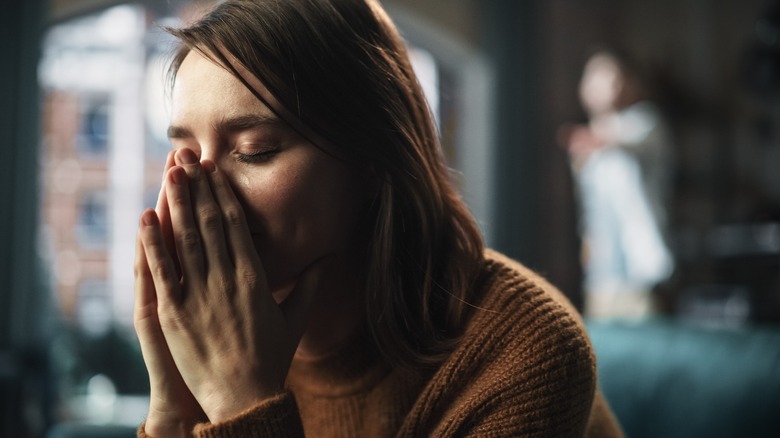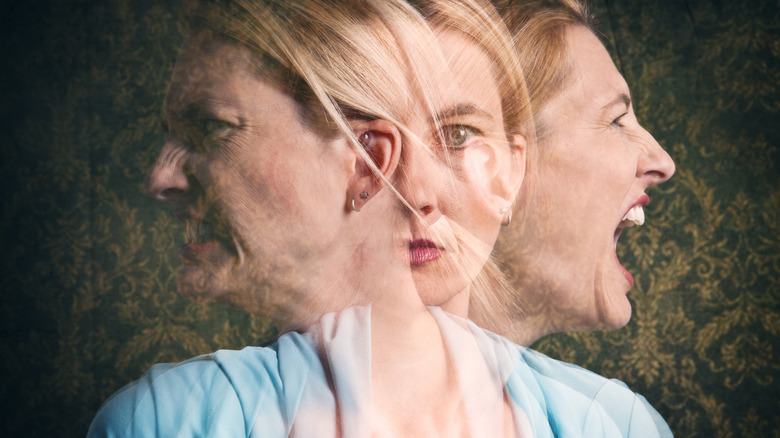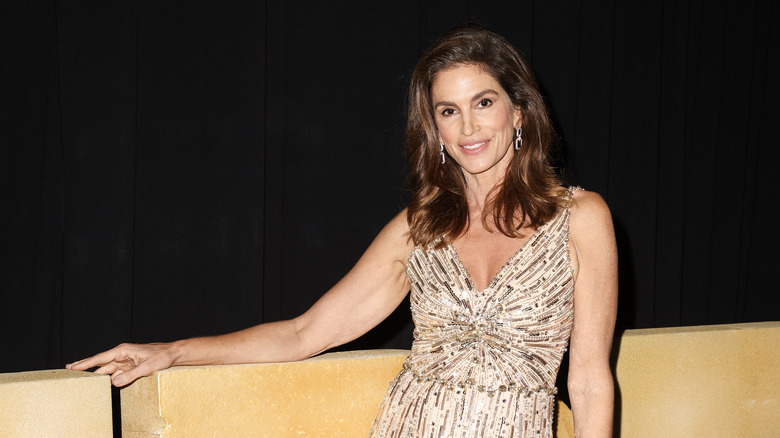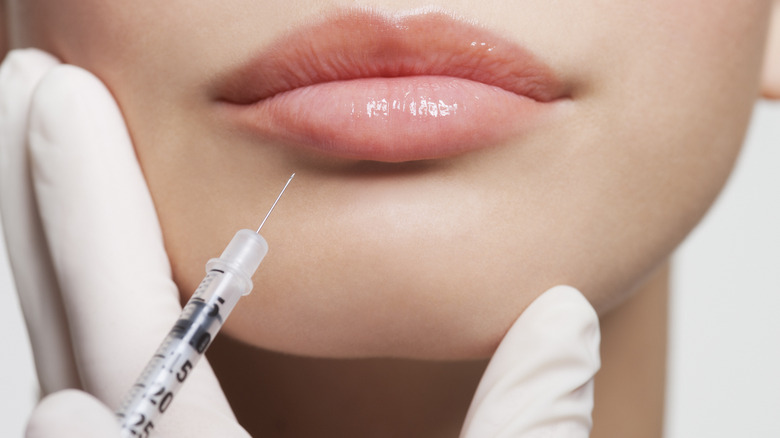Why Your Perception Of Attractiveness Might Be Skewed
The age-old cliche rings true — beauty is in the eye of the beholder, but what frame of reference does the proverbial "beholder" use to form their judgments on attractiveness? Countless influences alter what we believe to be beautiful — think of Coco Channel's glamorously bronzed return from the French Riviera and the subsequent shift in a centuries-long preference for pale skin, or Kylie Jenner's lip filler that sent people running to their plastic surgeons. Conversely, some aspects of objective attractiveness are proven to be timeless and accurate across the globe, such as facial symmetry, smooth skin, and muscle tone — evolutionary signs of fertility, good health, and good genes that can be passed on to future generations. In fact, multiple factors inform what we perceive to be attractive, and many other factors distort our perception of actual human attractiveness.
In the digital age, we face information and images that fundamentally shift what we believe to be authentic. Though the blame cannot entirely be placed upon the internet, as damage is being done to our perceptions of attractiveness in the real world through the perpetuation of impossible beauty standards, harmful normalization of distorted expectations of women, and an internalized competitiveness that deludes us into believing that to be happy is to be better, smarter, and prettier than those around us.
Fear of being average
Roger Covin, Ph. D, states that the term "average" has been deemed derogatory in Western culture, where everyone seeks to be ahead of the curve. We have been taught to resent the designation of "average," and we seek to avoid feeling as if we are merely in the middle of the herd, even if it means conceding to delusion.
According to his article for the Huffington Post, statistics suggest that on an attractiveness scale of one to 10, most people would fall from three to seven. Mathematically speaking, the majority has to fall within the average, as the scale would shift if more people were more or less attractive. However, during Dr. Covin's research, he found that most people rated themselves from seven to eight in attractiveness to avoid being defined as "only average." Our avoidance of one particular designation skews our perception because it is based on a personal aversion to an arbitrary mathematical reality that most people are average.
Dr. Covin warns against misunderstanding the implications of being averagely attractive, and he assures readers that there is nothing wrong with falling in the middle of the scale when he says, "People who are approximately the same in terms of their level of physical attractiveness are more likely to form relationships ... If the majority of people are in the average range and people within this range are most likely to be attracted to one another, then there is no critical need to be in the upper echelon of beauty."
Only seeing the best on social media
As social media encroaches further into every corner of our lives, it becomes easier to be deluded into perceiving someone else's portrayed Instagram fantasy as reality. The photos displayed across timelines are carefully curated, edited, and filtered to catch the eyes of those scrolling by, and they are often not faithful representations of real life. Because we spend so much time on social media, we begin to forget what the real world — and real people — actually look like, and we judge them based on a virtual imitation that frequently fails to meet expectations.
To make matters worse, social media not only damages our view of others as we compare their online persona with that of real life, but it also affects how we view ourselves. One of the tools we use to determine where we stand among others in terms of attractiveness is social comparison, wherein we observe those around us and assess our rank among them based on specific criteria, according to Dr. Covin. He iterates in his article that the role of social comparison is being misunderstood by social media users when he states, "Unfortunately, many people do not use social comparison appropriately ... you must look at people more attractive than you and those you consider less attractive. The problem is that many people only compare upwards[.]"
Viewing your own body more critically than you view others
Since we exist in our bodies every day, we are more attuned to its pieces and parts, how it functions, and especially how it looks. Being frequently exposed to our slightest flaws and misgivings about our appearance can make us feel as if we have more of them than other people do. This heightened awareness of our insecurities makes us focus on the parts of ourselves that we dislike or find unattractive.
A study by students of the University of Barcelona dove into the discrepancies between how women think they look, how they actually look, and how attractive they find themselves to be when observing their bodies from an onlooker's eyes. Researchers first asked women to rate their attractiveness when viewed in a first-person perspective (in a mirror). Their answers were recorded, and their exact measurements were taken to produce a digital 3D rendering of their bodies to be judged later by the same participants. The result showed that they found themselves more attractive when they viewed their virtual "avatars" from an outsider's perspective.
The study highlights how easy it is to forget our attractive features when we always see ourselves from the same angle every day, and it further explains how our prolonged exposure to only one side of ourselves makes us focus on what we define as unattractive features.
Perceptions and preferences change with trends and location
Our perception of attractiveness is malleable, and our preferences change almost as frequently as trends do. Our views of attractiveness are also altered by our location and the preferences of those around us. Some elements of attractiveness hold firm no matter where you are, but many cultural factors play into what we find desirable. When we are removed from one culture and its preferences and place ourselves within another, our concept of attractiveness shifts to match the majority's views.
A study published in the Journal of Evolution and Human Behavior describes how the perceptions of attractiveness in men of rural South Africa changed when they moved to the UK, and their preferences became more closely related to their new counterparts. Researchers stated, "We show that there are striking differences in attractiveness preferences for female bodies between United Kingdom (UK) Caucasian and South African Zulu observers. These differences can be explained by different local optima for survival and reproduction in the two environments."
Trends also impact what we perceive to be attractive. In the past, trends took much longer to circulate, but with the immediacy of the internet, it takes a fraction of the time for them to take hold. In a statement given to BBC, assistant professor at the Johns Hopkins University Carey Business School, Haiyang Yang argues, "The advent of the internet age may be causing people to change their beauty standards faster than ever before in human history."
Monetized insecurities in the beauty industry
The beauty industry rakes in billions of dollars annually by pushing unrealistic beauty standards upon consumers and then selling them "solutions" to cure their new-found insecurities. Marketing tactics targeted toward altering how natural bodies look, and function (such as body hair removal, face tapes, and pore-minimizing products) garner discomfort in women as they question if something is wrong with their naturally functioning bodies. Thus, women seek solutions to unsolvable problems and harbor unrealistic and unattainable ideas for how they and others should look.
In an article published in The Brown Daily Herald, author Yael Wellisch describes the vicious cycle of the perpetuation of impossible beauty standards by executives in the cosmetic industry and the goods offered to heal the wounds they themselves have inflicted when she writes, "Consumers...often feel compelled to purchase a product when they are reminded of their weaknesses or deficits...a threat to such a consumer's self-esteem, confidence or control often results in the desire to purchase a product that can restore what they believe is lacking."
In short, self-love does not sell cosmetics; therefore, the beauty industry continuously manufactures not only new products but new "flaws" of which women should be aware and seek to fix in order to avoid judgment from those around them. The harmful mechanism that exacerbates the problem faced by women distorts others' perceptions of attractiveness because it is an entirely man-made issue that shifts our understanding of what attractiveness really is and how it is achieved.
Prevalence of body-altering software
Facetune, Photoshop, and filters on Instagram, Snapchat, and TikTok are easily accessible and user-friendly tools marketed toward social media users as confidence boosters and means by which people can perfect and beautify their posts before sending them out into the world for others to see. But as author Julianna Strano wrote in her article for the University of Arizona's student newspaper, The Daily Wildcat, editing apps can be detrimental to a user's sense of self-awareness and perceptions of attractiveness in one's self. She states, "With just a few taps, we can morph our faces and bodies into a completely unrecognizable figure. It can get to the point where we don't truly know what we look like anymore."
Strano goes on to say that the more we edit and alter the way we look in our photos, the more we are likely to believe that we actually look like the retouched photos, and issues arise when the person we see in the mirror does not faithfully reflect the image of ourselves we have painted with the help of these apps.
The impact of photo editing apps geared toward average social media users has been so immense that the term "Snapchat Dysmorphia" has been implemented by medical professionals who are seeing a concerning rise in clients seeking medical assistance to look like they do on screen in real life.
Toxic cultural norms
Unfortunately for women, unhealthy cultural norms play a substantial role in our perception of attractiveness, especially in ourselves.
In a 2006 study published in Body Image, researchers stated, "A Canadian health survey revealed that 85–90% of women dislike their bodies... Women report lower body satisfaction..., are more likely to diet..., and have higher rates of eating disorders...than men do." These hardships are centered on the normalization of harmful cultural norms aimed toward women and the hyperawareness of women's bodies, making them more conscious of being perceived by others.
The study also revealed that due to heightened aesthetic expectations set for women, they more often compare themselves to unrealistic beauty standards and face more social encouragement to be hyper-critical of their appearance than men. When body image issues are engrained and normalized in society, our sense of what is healthy and attainable shifts away from reality. Damaging beliefs and social pressure reinforce this discrepancy.
Projecting personal insecurities
According to Psychology Today, projection occurs when we place our own attributes upon others by externalizing our feelings and assigning them elsewhere. This includes the projection of physical insecurities.
For example, if a person is bullied for having a nose of a particular shape when they are young and are taught from that point that others view their nose as unattractive, they might resent that feature. Rather than practicing self-acceptance, that person's negative feelings toward their nose might be directed toward someone who shares that nose shape.
If we see one of our self-perceived "undesirable" traits featured in another person, we are likely to view them as unattractive in the same way we view ourselves as ugly. This can damage our relationships with others and prevent us from considering a person as a human being independent of ourselves, our thoughts, and our feelings. Being blinded by our misgivings about our looks can prevent us from growing to appreciate our features in other people who may wear them proudly and encourage us to do the same.
Unrealistic representations of beauty in media
The representations of women we see in the media are so far removed from reality that even the models often find those images of themselves unrecognizable. In the documentary "Killing Us Softly: Advertising's Image of Women," super-model Cindy Crawfordsaid, "I wish I looked like Cindy Crawford," in reference to the amount of retouching that happens to her photos after they are taken and before they are released to the public.
These edited photos and videos are presented to consumers as accurate representations of what these women look like, though that's far from the truth. Not only are the models portrayed in the media aided by teams of makeup artists and hair stylists in the hours leading up to capturing an image, but hours of post-photoshoot retouching further distort the natural features of the person being photographed.
We are exposed to these unrealistic images constantly. Because they are so deeply ingrained into our daily routines, we begin to wonder if we, real people, are the problem rather than the manufactured picture of perfection.
Prevalence of cosmetic surgery and crafted beauty
With the growing accessibility of cosmetic surgery in conjunction with celebrity influence from families such as the Kardashians, medical professionals are noticing higher volumes of body dysmorphia cases among their patients. As stated earlier, the recently coined term "Snapchat Dysmorphia" also plays into an ever-increasing demand for permanent alterations to a person's body via plastic surgery.
According to an article for PubMed Central, of the 21 million cosmetic procedures performed in 2015, 15.9 million of them occurred in the United States. The same article states that in the UK, the number of cosmetic procedures increased by 300% from 2002 to 2014. This stark increase in operations coincides with the rise of social media and mainstream television, which trivializes cosmetic surgery and morphs our beauty standards and views of attractiveness so that they are only attainable through costly and often permanent procedures.
When faced with a plethora of images and endorsements for cosmetic procedures, even those which are non-invasive and temporary, such as Botox and facial fillers, we begin to take those artificial features for granted and engrain them into our consciousness as a standard one must aspire to achieve, even if a medical professional becomes a necessary part of the equation.
Seeing your features more often than ever before
The director of the Facial Plastic and Reconstructive Department at Johns Hopkins University School of Medicine, Dr. Patrick Byrne, argues that there has never been a point in history wherein people have encountered their own image as frequently as we do now. Until relatively recently, only the very rich and powerful were able to pay for the painting of their portraits and the taking of photographs. In the present day, most people have access to some variation of a photo/video capturing device, and it has fundamentally changed how we view and think of ourselves in terms of physical attractiveness.
In a statement given to CNN, Dr. Byrne explained that because people see themselves more often now through images and videos, we are more frequently exposed to our perceived flaws, and we become increasingly critical of what we see. Not only are we seeing more of our features, but we're also seeing more of what others post online.
Obsession with unattainable perfection
Body dysmorphia is a term that has been steadily growing in prevalence since the dawn of social media and the instant, large-scale sharing of millions of videos and images across the world. According to an article published in the Journal of Clinics and Dermatology, body dysmorphia is defined as "the obsession with perfection...the impairing preoccupation with a nonexistent or minimal flaw in appearance." This inhibits people who suffer from body dysmorphia from perceiving themselves as attractive on account of harboring an obsession with an objectively minor flaw.
This disorder fundamentally alters one's perception of their attractiveness because their focus is held entirely by one menial detail that only makes up a small portion of their appearance. Human beings are not comprised only of what we deem to be "unappealing features."
Accepting our flaws allows us to see a broader and more complete image of ourselves and allows us to have a more well-rounded idea of what we look like.
